How to Create Smart Literacy Centers that Last All Year
Literacy centers can be a blessing or a pain. I think it all hinges on the design, organization and effectiveness behind them that makes a difference. This is my philosophy on how to create literacy centers that are smart for me, the teacher, and effective for my kindergarten students.
I think that literacy centers for kindergarten can last an entire year, have little to no upkeep and can grow with students, putting them in charge of differentiation, offer choice and be open-ended.
What I’m not saying is that I think literacy centers can take no work on the teacher’s part.
In fact, I think it’s the exact opposite.
I think creating centers for kindergarten that are smart allow you to be the most effective at teaching. This is totally my own opinion and based on my teaching experience. {Just sayin’}
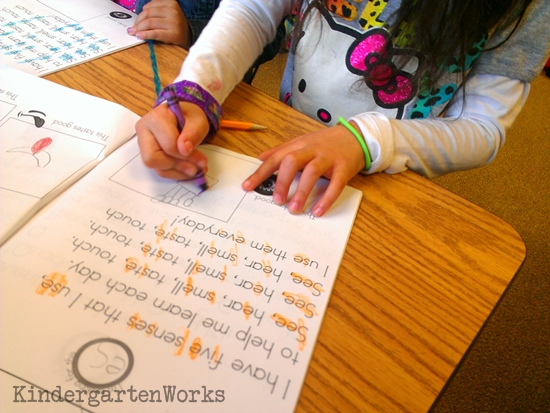
Work smart
In our classroom, literacy centers is a time for learning and playing to happen together. And we take that job seriously! I have worked and re-worked my kindergarten literacy centers, but I fall in love with them more each year as I tweak the process!
I’m the kind of teacher who likes to work hard up front, but also work smart so that the effort I put in lasts all year long.
In saying that, my literacy centers do not change. They stay the same all year. They grow with my kinders as they grow by leaps and bounds. We use interactive, manipulative (which feels like play to kinders) ways of learning literacy.
We have 14 different standards-based centers that work on many of the same skills but with varied materials – so every center feels unique to my kinders.
They are all reading, writing or word work centers.
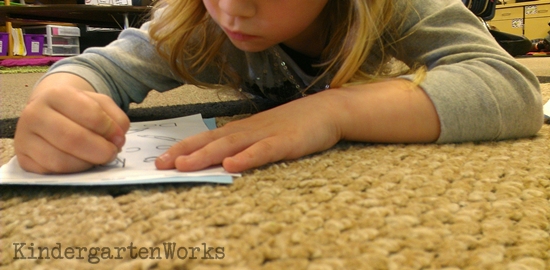
Here’s my list of kindergarten center ideas. {Dum da dum} Click on any link to read more about the center set up, expectations and standards.
My list of year-long centers
Reading centers:
Word work centers:
Writing centers:
- Author Writing
- Illustrator
Set up for independence
Kinders are great at using labels with pictures to put things away and find them again, so my classroom is covered! I put lots of icons directly onto the container or bin to provide lots of visual support.
Centers can pretty much be done anywhere within the classroom, but my kinders often complete the activities wherever I first modeled them. They are routine-based creatures, aren’t they? I’ll admit – I am too!
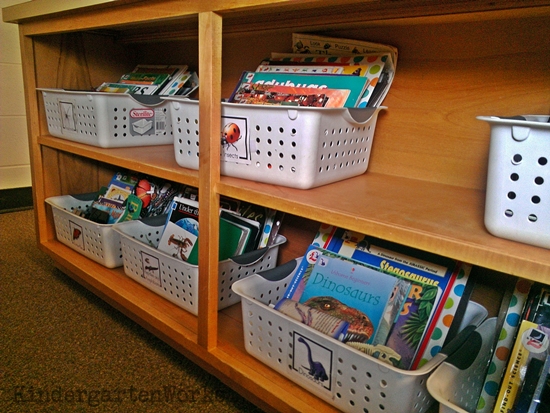
I include literacy center posters for each center that illustrates with picture icons what options students have.
These posters help me teach the center at the beginning of the year, help me keep students on track throughout the year and inform administration as time goes on since they have all of our common core standards listed out.
Routines make centers successful since when students know what is expected, they are much more likely to rise to those expectations.
When I’m working with small groups of students, this also gives me the opportunity to offer suggestions on how they can take and apply what we’ve learned in a small group back to practice at their center.
Building upon their regular routine with new skills or challenges keeps things fresh, but with solid expectations.
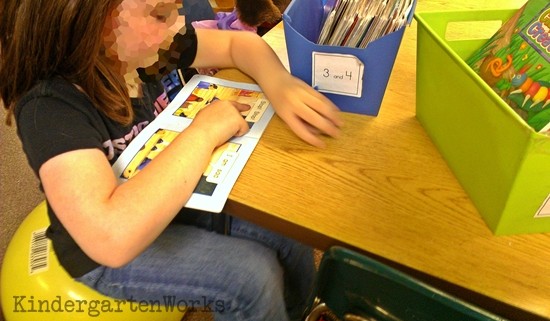
Why I create centers the way I do
Time
Time is a huge factor. I need time to teach small groups while other students work independently.
I also need the time I spend creating something for a center to be worthwhile. If it doesn’t last a long time, forget it – it wasn’t worth it.
And lastly, the time I spend creating and setting up should be able to set the long term value my students get out of it.
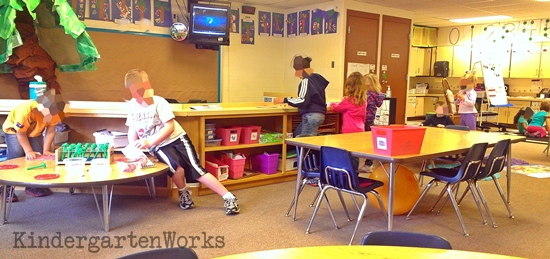
Modeling = working smart
I want any modeling or teaching that I do whole group or in my small group lessons be something that students can try on their own.
I want to be able to capitalize on what we’re already doing and utilize the skill or method.
If I were to have to model new centers past the first 30 days of school, I don’t feel that’s a worthwhile use of my time.
I’d much rather use sharing time edifying students who are challenging themselves or model a new way to extend their thinking in a center they are already used to.
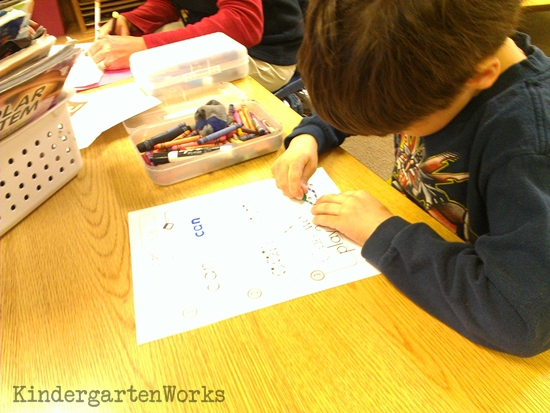
Open-ended = flexibility
Creating a center that is open-ended is the smartest kind of work for me.
By making the kindergarten center activities be choices or have options then I also have flexibility to meet with students or groups for as long as I need.
This flexibility level alone makes me a more relaxed, happy and confident teacher knowing I can get it all done.
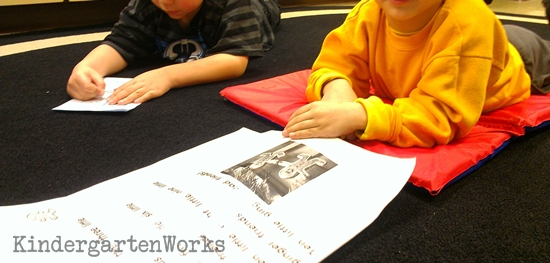
Productive = effective
My thinking is that if I can create centers where students can be productive and engaged then that is going to be much more effective in the long run.
Motivation, interest, and choice all play into the work that goes on during our center time.
Plus, I figure if there is a center they don’t love, they only have to visit it once (maybe twice) a week and will enjoy practicing the same skill at another center with different materials.
How I roll them out
This is my 4-step process for rolling out centers.
I start with one center on day 1 of my introduction schedule and build upon that each day until a center has rolled through each step of the 4-step process.
During this time, we are building both stamina for working and fully understanding what to do and not do.
Most days I am introducing one literacy center, modeling one center, practicing one center and reviewing 1-3 centers. This is how we quickly build up our stamina.
1. Introduce
- I first introduce a center with it’s name, icon and location in the classroom.
- I describe our main goal for the center and pick one choice to model.
- I explain my expectations of getting items out and putting them back with the actual objects.
2. Model
- I review the name, icon and location from the previous day.
- I model what to do and what not to do.
- I get ridiculous with some of my not to do’s to keep short attention spans on me.
- Someone helps model where to put materials away.
3. Practice
- Students point out the location, give the name when I show the icon.
- Someone models what to do.
- Someone copies a model of mine what not do to.
- Small groups of 3-4 “practice” for 1 minute doing it the right way and placing the materials back on the shelf. Note: We practice the listening center whole group.
4. Review
- Review what to do, what not to do, where its located and choice option.
If a literacy center has more than one choice/option then I start on the modeling step for that activity when I decide to teach it later on. I will make sure that they have the first activity down pat before teaching another at the same center. There’s no reason to add mayhem to madness otherwise.
It normally takes me about 20 days of actively teaching the centers.
Say what? Isn’t that a waste of time at the beginning of the year?
Umm… no.
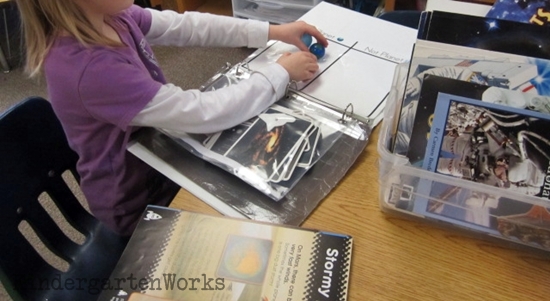
In the beginning of the school year there is no routine to our day. So, I take advantage of this flexible teaching time to gradually build up the time we spend doing literacy centers.
Once we have learned how to effectively do one activity at at least 5-6 centers, then we take the following day to actually “do” a center rotation.
On this day we are also learning to read the workboard. They learn to find their name, go there and stay there.
Now, we can add one rotation into our normal daily routine and schedule. And even though we begin cycling through one center a day, I continue to build upon our knowledge of the other centers using the same 4 step process.
Spending this time up front saves me time all year long. {Working smart, remember?}
When we have built up enough knowledge of 8-10 centers, we begin to rotate through two centers a day.
During this time, I begin to experiment with pulling a small group to teach them the ABC center. It’s a little harder to “practice” and experience in the 1 minute I generally give the others. I want to reinforce the ‘must do’ portion of that center before students work on the open-ended piece.
A note on pulling students: I do not make myself a center. So, I teach them that the reason we do these literacy centers is so they can keep on learning while I’m teaching each of them in a small group. I essentially let them know there is no complaining about being pulled since it’s the reason we do centers – so others can keep learning while they get their turn with me. We hit that one right off the bat and I’ve never had an issue!
Purchase centers – instant downloads
I have rounded up as many centers as I could for you to purchase complete with the instant download materials needed along with the poster and workboard icon to make each center a complete package.
- Library/Listening/Big Book/Puppet/Retell/Puzzle/Author Writing/Illustrator
- Computer
- Poetry
- Non-Fiction (Free)
- Playdough
- ABC
- Pokey Pinning
- Detective
A little more about the first product listed – It’s just that there are a few centers that don’t need tons of materials from me – rather, materials that you already have on hand!
Score, right?
So, I’ve bundled those particular center posters and organization labels into a Literacy Center Poster and Workboard Icon set.
[Continued] How do you…
You asked. I answered.
- How do you rotate centers? How often? What’s the routine? What does your workboard look like?
- Where can students work during center time?
Think I’m crazy for doing centers this way? What are your thoughts on making centers smart?
If you like what I do here on KindergartenWorks, then be sure to subscribe today. I look forward to sharing ideas with you weekly.



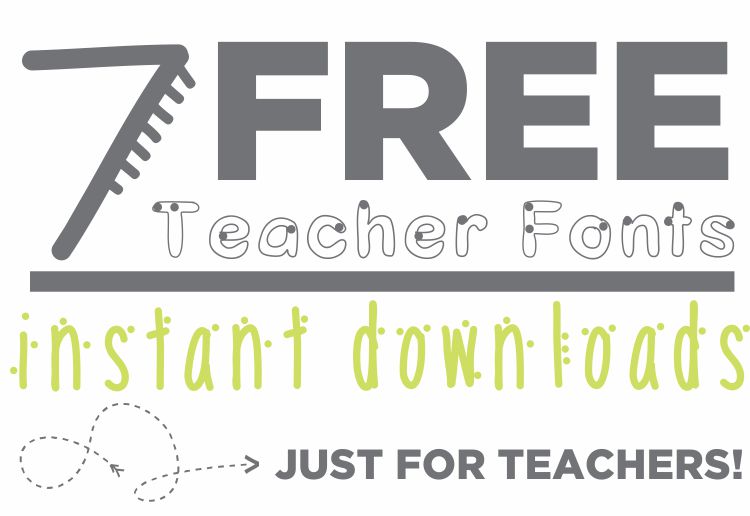
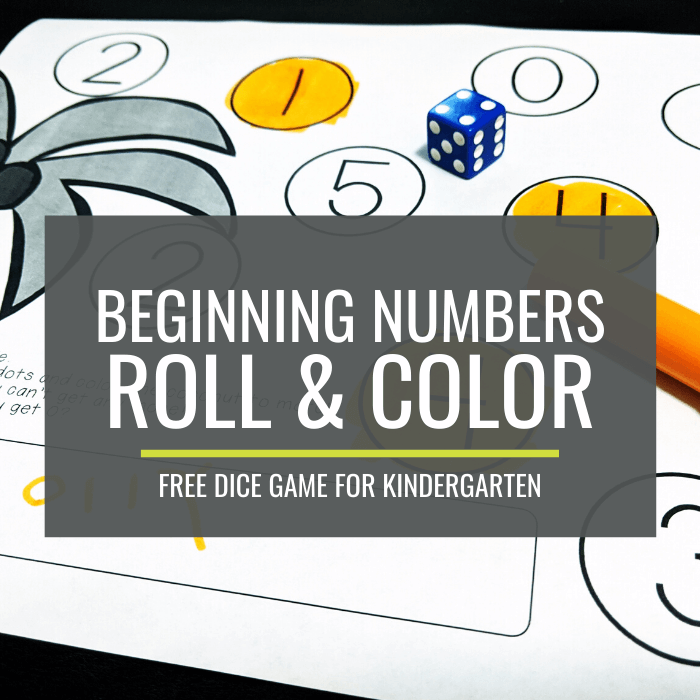
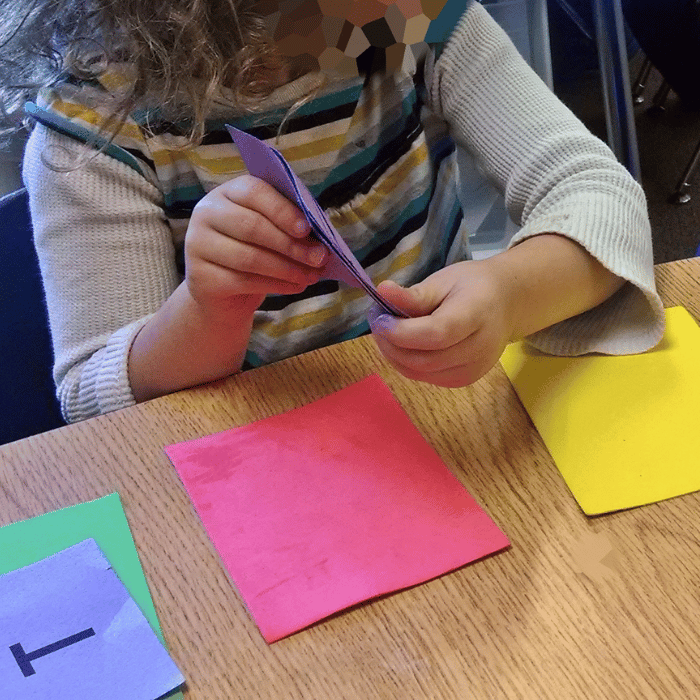
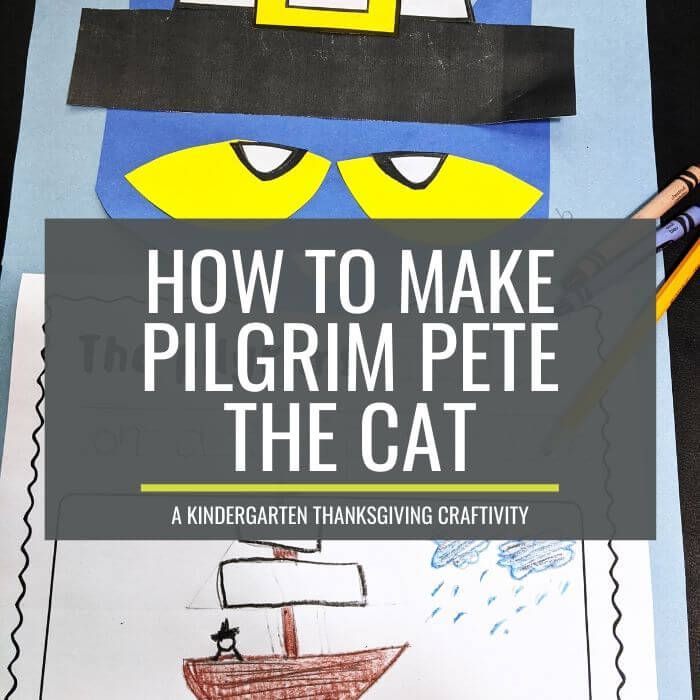

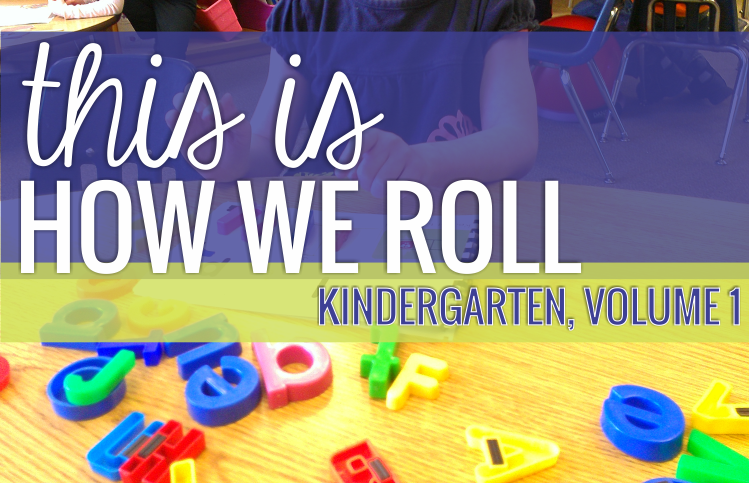
Awesome! Literacy centers can actually be a blessing if organized smartly. It’s amazing how organized you are. I loved this post.
Good Evening
First let me say I am new to kindergarten and I am always looking for new ideas for my literacy centers. I was interested in an activity that one of your students ( picture) is doing . The student is drawing , the student has highlighted “es” in orange…. is it a poetry or some sort of word work ?? Thank you for your help….
Welcome to the world of kindergarten, Sue! That child is working at the listening center – she is listening to and following directions with a familiar poem that we worked on the whole week prior. The poems in that booklet format can be found here: https://www.teacherspayteachers.com/Product/Poetry-Notebooks-88597 (although the listening directions on CD are not included – just an fyi). I hope that can help!
– Leslie
How long is your center time? What does your schedule look like in kindergarten? Curious to see how you fit it all in! How would you run a 30 minute RTI time where 4 kids are pulled out and the other 9 are with you for guided reading time?
Hi Carrie – here is a little more about how long our center time is: https://www.kindergartenworks.com/teacher-organization/details/. Our schedule looked similar to this (but from my teacher perspective) https://www.kindergartenworks.com/kindergarten-teaching-ideas/teacher-day-in-the-life-schedule/. I’d run an RTI time just like I would a GR group time – but not at a table with 9 kiddos. I’d be doing things with them up close to me but on the carpet just for space reasons. Here’s how I tweaked my groups to “fit in” all the stuff we have to teach nowadays, which you could do something similar during that pull time: https://www.kindergartenworks.com/guided-reading/modified-guided-reading-groups/. I hope that can help you as you’re settling into your schedule!
– Leslie
Genius! Moving to K from second grade and I’ve read lots of blogs/discussed with future colleagues. But I love your smart way of setting everything up front and not having to make tons of changes after that. Thank you so much for sharing!
How do you keep kids accountable for what they do during centers? If there is no record sheet or worksheet to complete, how do you know they actually did something? I’m excited to implement this idea of centers, but the accountability aspect has me feeling hesitant.
Meg, you’re right that there is not always a “recording” sheet or worksheet to verify they did something. It’s not a system with 100% “accountability” in that perspective.
Some centers have a completed component (ABC, pokey pinning, listening centers for example) but a finished product for every single center is not age appropriate in my opinion.
Plenty of students bring what they worked on to show after a center is over and we host a quick sharing opportunity for a few students before a mini lesson takes place in between two centers. This is a great way for students who made manipulative things with playdough or magnetic letters – or students who read a book they want to share – to bring those typically “non recorded” products to share.
I assume you could use a digital camera for students to take photos of their work or record themselves reading aloud using apps like SeeSaw nowadays if you need to show a product for every time spent at a center for administration.
There is value in the repetition of these centers and for students to have choice. With that often comes, which I’ve found to be much higher quality time spent learning, engaging and exploring. I felt pretty connected with the classroom through sharing and visual checks (and sometimes physical ones) around the classroom that they were indeed doing something!
Hi! Love this blog post about year long literacy centers. I am wondering if you do something similar for math centers?
Hi Leigh-Ann, I do! The centers themselves don’t change over the year but the contents do. Here is more on how we do guided math: https://www.kindergartenworks.com/category/guided-math/
I’m looking for your non-fiction center. When I click on the link it says that the page cannot be found.
Hi Meg, you can check that out here: https://www.kindergartenworks.com/kindergarten-teaching-ideas/non-fiction-literacy-center/. Thanks!
Hey! I teach K and love these! Do you have a particular order you introduce them? We also have free play centers (dramatic play, blocks, etc.) but I want to use these as well.
Hi Laura,
I have written out a schedule for myself. I start out with the most basic (like the library center) and then the ones that are closest to what we do everyday (like the poetry center). Here is a list of how I introduce them no matter which one I decide to start with: https://www.kindergartenworks.com/teacher-organization/details/.
First year kinder teacher here and I couldn’t be more thrilled to have found your blog. So many amazing tools available. I can’t wait to start digging in!
I’ve purchased some of the Literacy centers One question I have is about the ABC center- Do you copy all the sheets at once and have them available for students to use?
Hi Patti – thanks for being a customer. I’ve made a packet with all of the sheets combined (like with a binding comb) and used that style for a couple of years. Then one year I only put out one sheet into the drawer for the week (just a class set worth of copies) and liked that system better. You could do it either way, but that’s what I ended up liking best.
What a great way to allow students the practice time they need while meeting the demands of administration. What kind of schedule do you use to implement the centers in the beginning of the year? What order do you teach the centers?
Hi Jenna,
Thanks! I start with one and when we’ve built up to enough we actually “do” one center (in larger groups than normal). Then we do one rotation from that point on until they are ready for 2. The order sometimes changes, but normally I start with the ones that are the most simplified in materials and choices. I like to start with 1 activity from these: library, playdough, poetry (because they’ve seen me do it whole group), pokey pinning and detective.
I’m loving this post! In my kindergarten class I normally have 24-26 students (which for me is 5 guided reading groups based on Fountas and Pinnell guided reading levels). I plan on meeting with all 5 groups each day. I normally only have 5 centers and just change them weekly (what a chore!).
After reading your post, I would like to do the following centers next year: Big Books, Word Work, Art (where they would do a word work center), listening, writing, Ipads, computers, read to self, poetry, playdoh, the interactive whiteboard, and Meet with Teacher. I just need help coming up with a rotation system. I would like to meet with students daily and for my literacy centers to last for at least two weeks. Could you recommend a center rotaionschedule that would work well?
Hi Mary,
Can I recommend considering pulling your students from centers to meet with you? That would remove you as a center, but allow you to make heterogenously-leveled center groups of 3-4 kids and most likely make your centers run more smoothly. That way you can pull as many groups as you want in a day (up to all 5) or pull fewer and give yourself more time with each group. It’s not necessary, but just an idea so you don’t feel super pressed for time – it was something that worked for me. It also gives you more flexibility with the number of groups rotating through centers (and the number of students per center)… which ends up giving you the ability to make a rotation schedule work easier.
If you had 11 centers then (from what you listed and removing yourself as a center) I’d recommend plugging them into a 5 day schedule by starting with the number of rotations you want them to go through. Mine only visited 1-2 centers twice in a week which helped keep things fresh. The rest they only visited once a week.
So, if you picked 3 rotations in a day (say 20 mins each) – you’d need to fill 15 center spaces. You’d have 5 groups – and just put their names/group in place of the days of the week in the scenario below. You’d space out the 11 centers so that the 4 most engaging centers (say, computers, iPads, big book, read to self) get plugged into your schedule 2x, while the rest only get plugged into the schedule 1x. You’d have 4-6 students per group roughly… but 1-2 would be potentially be missing at any given time since you’d be pulling some to read with you.
Something like:
Weekdays M – T – W – R – F
Rotation 1 BB – WW – A – L – C
Rotation 2 iP – R – PT – C – PD
Rotation 3 WG – C – BB – iP – WB
If you picked 4 rotations in a day (say 15 mins each) – you’d need to fill 20 center spaces. You’d plug most of 11 centers into your schedule 2x (trying to space them out if possible), while the remaining only get plugged into the schedule 1x. You’d still have 5 groups of roughly 4-6 students. They would rotate through more centers in a day.
Something like:
Weekdays M – T – W – R – F
Rotation 1 BB – WW – A – L – C
Rotation 2 iP – R – C – PT – PD
Rotation 3 A – PT – iP – BB – WB
Rotation 4 C – L – PD – WG – WW
With this type of system if you put out specific items that you want to last 2 weeks, just keep in mind how often they’ll repeat the activity in that time frame. Some centers that’ll be no issue- like the big book center… they just read 😉 If you offer some choices (say 3 poems available at the poetry center, or a handful of books at the listening center) then you can definitely make the other centers last two weeks without feeling like you have to change out materials (new poems/books).
I hope that can help! If you want to keep 5 groups, you may want to consider adding a library center (splitting read to self into 2 centers essentially – one with leveled books, one with regular trade books) to throw into the rotation.
I wish you all the best as you work out a rotation schedule – I always have to sketch it out to see if it’d work!
– Leslie
Leslie, I applaud all of the work you have done! I went back to Reading Centers this year after struggling with rotating with book boxes and guided reading groups. The Centers were similar to yours (less organized and done than yours!). I LOVE pulling my groups during the center time–so much more freedom to teach groups (now that I am without a para). I highly recommend this system to K-1 teachers.
Hi Kathy, thanks so much for your recognition and I’m so glad to hear that you’ve got a system that is working beautifully for you! And I’m glad that you’re back in love with pulling groups 😉
that is good stuff.
– Leslie
Leslie,
Thank you for this! This is very similar to how I like to do centers because it is time saving for me! 🙂 I agree with Desiree – I would love a post about your ABC center too! Always nice to read more about it! Also – on the choice boards for each center – do you include all the choices all year or just one or two to start out and add more or does it depend on the center? I hope that makes sense. For example on the playdough center choice board you have 4 choices – make the letter, make rhyming words, make 3 letter words and make sight words or put alpha in order. Do they do all of those in the beginning? or do you just start with one or two? Thanks! Just trying to compare and get more info! Kristin
Hi Kristin, I do only start with 1 activity choice for each center. That way I can see how they can handle themselves and they can truly focus – and then it keeps things fresh over the first semester as I add new choices in. Thanks for the reminder about the abc center blog post! It’s fun to find another teacher who thinks alike. Have a fantastic year.
Leslie
I totally wrote about it! Let me know your thoughts and I hope it was helpful:
https://www.kindergartenworks.com/common-core-standards/abc-literacy-center/
Leslie, do you have a post where you talk more about your ABC center? I clicked on the link but it brings me to your poster set. I would really love to know how you incorporate the see, stamp, write journal into your center. Thanks.
Hi Desiree,
I don’t actually have a post dedicated to that center yet. Those pages – 1 per week are the basis for this center. This happens to be a center where the students must finish the front side of the paper by stamping, writing and reading the sight word. Then the back is the open-ended section of the center and the students get to choose the alphabet manipulatives they’d like to work with (magnets, letter beads, velcro letters, scrabble tiles, etc.) There are workmats that are like task cards in that they give students direction on some possibilities for word work. They choose one to make and record their work on the back of the worksheet. I’ll have to see about adding that post to my list of upcoming ideas!
– Leslie
Desiree – I hope you got a chance to see this recent post: https://www.kindergartenworks.com/common-core-standards/abc-literacy-center/. Thanks!
Loving your new look Leslie! Fabulous!
Hey, thanks Tamara!
Hi! I also teach kindergarten and centers are the kids favorite part of the day. But I do not love them as much because I feel like I am constantly having to find/ get out new materials to add to the center and then explain them all again which takes so much time. I am interested to see all of your explanations once you post them! Thanks for sharing!!
Kari 🙂
Thanks Shannon! I enjoy your blog too – fun ideas!
WoW!! I can’t believe how organized you are…I am in complete and utter awe!!! I just stumbled across your blog and it is awesome, I am so glad I found it 🙂
Shannon
kinder-pond.blogspot.com
Jana, The poetry notebooks are a collection of poems we use. We do one each week whole group and then use those poems in centers the following week. I have created a CD to go along with each poem that gives step-by-step directions of what to do with the poem and they also listen to each poem as a song multiple times throughout the CD.
Thanks Melissa and LeAnne for commenting!
Hi there,
Could you explain the poetry journals to me? Are the poems you use on cd?
Oh, and I also like how you titled it learningplaying! My kiddos often ask each other, “Do you want to play at ___ station with me?” or they call workshop playtime. They really don’t make the connection that they’re learning while completing their tasks!
I can’t wait to see them all! I also teach K, but we do workshop in our school, so the kids move freely from station to station. I do many of the same types of stations, but I also include math, science, and projects in my mix. I’m interested in seeing how you build upon them rather than planning new things for each station every week (which is how I do mine).